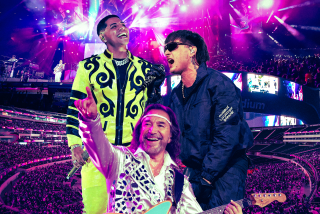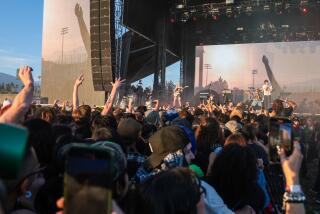Concert of Death : Cities Rethink ‘Festival Seating’ After Three AC/DC Fans Die
- Share via
It was his first concert.
The arena was dark.
The crowd was wired.
More than 13,000 fans were packed into the Salt Palace that Jan. 18 night to see the Australian hard-rock band AC/DC and 14-year-old Curtis Child had managed to elbow his way into a choice spot near the front of the main floor.
When AC/DC finally appeared, a mob of fans charged the stage. Not an unusual occurance at general-admission rock concerts, where ticket-holders typically push and shove their way forward trying to get as close to the band as possible.
But this time, something went wrong.
The crush swelled. Panic set in. Kids started screaming. Security guards lost control. Bodies began stacking up, like dominoes, in front of the stage.
Before AC/DC could stop the show, half a dozen people were seriously injured. Three were taken from the concert in comas and later died.
Autopsy reports reveal that Child--along with Elizabeth Glausi, 19, and Jimmie Boyd, 14--died of “compression asphyxiation,” a condition in which the lungs are crushed so badly it becomes impossible to breathe.
“No parent should ever have to face such a tragic and senseless death as my son’s--especially as the result of a rock ‘n’ roll show,” said Bruce C. Child, whose son died as a result of the Jan. 18 stampede, in a telephone interview Friday.
“This was his first concert. Honestly, I was much more concerned about something happening to him in a car on the way down or back. I had no idea that things like this went on.”
Child blames his son’s death on “festival seating”--a practice in which promoters remove seats from the main floor of an arena or stadium and allow ticket-holders to sit or stand where they please.
Festival seating arrangements have been prohibited in Los Angeles by order of the Fire Prevention Bureau since 1982. Other Southland fire departments have instituted similar measures. (A Grateful Dead concert in December, 1989, at the Forum in Inglewood has been the sole exception.)
However, an estimated 15% of the 6,000 U.S. rock shows presented around the country each year in auditoriums with 10,000 or more capacity do employ festival seating, according to the North American Concert Assn.. Despite the tragedy in Utah, most promoters defend “festival seating” as a safe alternative to reserved seating.
But in an $8-million civil suit filed last month in the 3rd District Court of Salt Lake County, Child blamed AC/DC, concert promoters and county officials with “willful, malicious conduct” in the death of his son. Parents of the other teen-agers are also reportedly considering legal action.
“Promoters and bands are putting greed and self interest over any consideration for the young people who are going to their concerts,” said R. Craig Clark, the San Diego attorney representing Bruce Child in the civil suit. “They are acting with a conscious disregard toward the safety of the consumers whom they sell their tickets to.
“We hope this suit will bring some sanity to the concert industry and help to change the unsafe nature of general admission seating arrangements.”
Following the Jan. 18 tragedy, Salt Lake County officials temporarily banned festival seating at all shows and launched an investigation into the matter. While the probe found no criminal negligence in the deaths, the Salt Lake City Council is currently conducting a review of pertinent ordinances and is reportedly leaning toward prohibiting the practice entirely.
And Salt Lake City is not the only community concerned about festival seating. Ordinances in Nashville, Denver, Atlanta and several cities in Ohio already restrict the practice and last week, San Francisco’s chief administrative officer, Rudy Nothenberg, called for a review of city codes regulating seating arrangements at Bay Area venues.
Not since 11 people were killed and 22 injured in 1979 at a general-admission concert by the Who outside Cincinnati’s Riverfront Coliseum has festival seating been such a point of contention around the nation.
Peter Luukko--western regional vice president of Spectacor Management Group, the Philadelphia-based company that produced the AC/DC concert in Salt Lake City--defended the practice, suggesting that a number of pop acts prefer the ambience general admission lends a performance.
In some cases, hard-rock bands such as the Grateful Dead and the Scorpions specifically request promoters to employ festival seating whenever possible.
“Festival seating isn’t just some money-hungry concept,” said Luukko, whose firm oversees events at 27 stadiums internationally, including the Los Angeles Sports Arena and the Coliseum. “It’s a form of seating that appeals to the fans of many of the biggest rock groups in the nation.”
Bill Graham, probably the nation’s most prominent promoter, believes young rock fans enjoy the social atmosphere available at general admission concerts.
Graham, who said he has staged more than 7,500 general admission Bay area concerts in the past 26 years without incident, met with San Francisco Mayor Art Agnos last week to voice his support for festival seating.
“If you ban festival seating, you ban an important part of what rock music is,” Graham said. “The people who are trying to stop it just don’t want the kids to have any social contact.”
While Los Angeles has no ordinance prohibiting festival seating, the city’s Fire Prevention Bureau instituted a de facto ban on the practice eight years ago following a Who concert at the Coliseum where several fans were treated for exhaustion.
Assistant Fire Marshall Tony Ennis, of the Los Angeles City Fire Department, said that the bureau believes festival seating is just too risky.
“It doesn’t take a rocket scientist to figure these things out,” Ennis said. “Festival seating presents crowd-control problems. The fans have a tendency to surge toward the stage. People get packed up. They can’t move or escape. And when that happens, somebody’s bound to get hurt.”
Attorney Craig agrees.
He claims that promoters do little to deal with the threat of fans suffering from dehydration or heat exhaustion other than station security guards with buckets and hoses of water to periodically wet the crowd down. Individuals who do faint, Clark said, are lifted above the throng and passed hand to hand by audience members until they reach safety.
“If your readers heard about a situation where some company was trying to contain dogs or cats under conditions as despicable as these kids are expected to endure,” Craig said. “Somebody would sic the Humane Society on them.”
In arenas where festival seating is still in force, promoters say they are attempting to prevent injury by introducing additional safety precautions. Security forces have been beefed up considerably and some companies are installing high-tech barricade configurations around the performers to reduce erratic rushes toward the stage.
The invention of retractable floor bleachers has made it possible for newer venues to set up large indoor concerts with assigned seating.
Brian Murphy, president of Los Angeles-based Avalon Attractions, believes there is still room for festival seating in the concert business.
“In the past 20 years there have been only two deadly episodes in the entire nation,” said Murphy, whose company puts on about 25 general-admission shows every year in Seattle, Fresno, Tucson and Phoenix. “What happened in Salt Lake City was a tragic fluke. If you’re asking me whether I think shows with festival seating can be put on safely, I’d have to say yes, I do.”
But Child, whose lawsuit against AC/DC is not expected to come to trial before December, has his doubts.
“I’m not anti-concert, but to have a venue set up in such a way that people are crushed together that tightly, to me, is incomprehensible,” the 39-year-old steel production worker said. “I think the promoters, the bands and the companies who own the buildings owe it to these young fans not to exploit them. And in my opinion, they simply are not doing their job.”
More to Read
The biggest entertainment stories
Get our big stories about Hollywood, film, television, music, arts, culture and more right in your inbox as soon as they publish.
You may occasionally receive promotional content from the Los Angeles Times.










